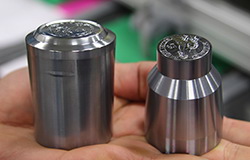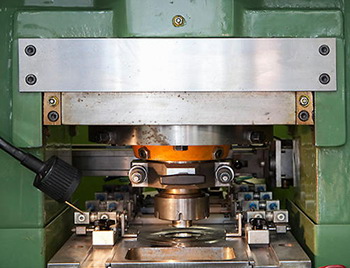Factories that produce coins are called mints. There are many steps involved in the making of a coin, just like there are with other manufactured products.
The Path: Design to Hub
Coins are designed by artists who start with a sketch of the coin. The sketch is engraved into a bas-relief representation made from plasticine or modeling wax. These representations will be 3 to 12 times the size of the eventual coin they depict. This negative model is used as a cast for a plaster negative. This new piece is touched up and refined, the proper inscriptions are added, and every detail is readied for printing. This negative is then used to ready a positive representation, also made from plaster.

This finalized model is sent to the proper authorities for approval. After it receives the go ahead, a model is made from the existing plaster in a hard epoxy. This new representation is then placed on an engraving machine (called a Janvier transfer engraver) designed to bring the coin down to the proper size. This machine transfers the properly-sized image into a hub or a master copy of the model for the coin.
The Path: Hub to Coinage Dies
This hub is heated to a very high temperature to make it hard, and it is put inside a hydraulic powered press. This machine presses the model into an untouched sheet of soft die steel to form a negative copy; resulting in a mold that is the master die. This die is used to form working hubs with the coin image. The same dies are used to make coins until they are worn, at which point they are replaced with new ones, all made from the same original hub. Thus, resulting in coins that are, in theory, identical.

The Path: Production of Blank Coins
The necessary metal for the specific coin is tested for purity, melded down, and made into ingots. These ingots are rolled into the proper thickness for the proposed coin, and this thin strip is rolled up so that it can be easily stored. When the time comes to make the blank coins these strips are put into a blanking press so the coin blanks can be punched out. Then these blank coins are fed into a sifter equipped with a bedplate containing holes of the proper width so that the diameter and weight of the rounds may be checked for quality control. Burrs are also taken off the coin edges in a separate process to ensure perfection.

The Path: Making the Coins
These accepted blanks are annealed or heated up to a temperature of 1,400 degrees and then cooled in a water bath. This bath makes certain that the crystal structure of the metal remains consistent throughout the metal. The soft metal state that results from the annealing process may cause crystallization, if this is not done. These cooled blanks are put into a chemical bath to rid them of any color distortions that may have resulted from the annealing. Next, the blanks are blow dried and put into an upsetting mill to raise the edges by just a little bit. The coins then enter into a striking machine where dies for both sides are set up with a collar to hold the blanks in place. The blanks fall into this machine from a hopper overhead for striking. After they are finalized, they are checked one last time and then packaged and shipped to banking centers within the Federal Reserve System.
